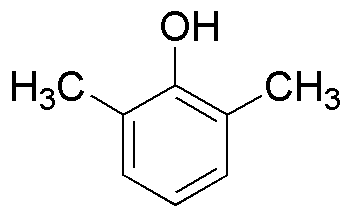2,6-Xylenol is widely utilized in research focused on:
- Antiseptic Formulations: Due to its antimicrobial properties, it is used in various antiseptic products, providing effective infection control in medical settings.
- Industrial Solvents: It serves as a solvent in the production of dyes and resins, enhancing the efficiency and quality of manufacturing processes.
- Chemical Synthesis: 2,6-Xylenol is a key intermediate in the synthesis of other chemicals, including pharmaceuticals and agrochemicals, streamlining production in these industries.
- Plastic Additives: It is used as an additive in plastics to improve thermal stability and resistance to degradation, which is crucial for enhancing product lifespan.
- Research Applications: In laboratories, it is utilized as a reagent in various chemical reactions, aiding researchers in developing new compounds and materials.
General Information
Properties
Safety and Regulations
Applications
2,6-Xylenol is widely utilized in research focused on:
- Antiseptic Formulations: Due to its antimicrobial properties, it is used in various antiseptic products, providing effective infection control in medical settings.
- Industrial Solvents: It serves as a solvent in the production of dyes and resins, enhancing the efficiency and quality of manufacturing processes.
- Chemical Synthesis: 2,6-Xylenol is a key intermediate in the synthesis of other chemicals, including pharmaceuticals and agrochemicals, streamlining production in these industries.
- Plastic Additives: It is used as an additive in plastics to improve thermal stability and resistance to degradation, which is crucial for enhancing product lifespan.
- Research Applications: In laboratories, it is utilized as a reagent in various chemical reactions, aiding researchers in developing new compounds and materials.
Documents
Safety Data Sheets (SDS)
The SDS provides comprehensive safety information on handling, storage, and disposal of the product.
Product Specification (PS)
The PS provides a comprehensive breakdown of the product’s properties, including chemical composition, physical state, purity, and storage requirements. It also details acceptable quality ranges and the product's intended applications.
Certificates of Analysis (COA)
Search for Certificates of Analysis (COA) by entering the products Lot Number. Lot and Batch Numbers can be found on a product’s label following the words ‘Lot’ or ‘Batch’.
*Catalog Number
*Lot Number
Certificates Of Origin (COO)
This COO confirms the country where the product was manufactured, and also details the materials and components used in it and whether it is derived from natural, synthetic, or other specific sources. This certificate may be required for customs, trade, and regulatory compliance.
*Catalog Number
*Lot Number
Safety Data Sheets (SDS)
The SDS provides comprehensive safety information on handling, storage, and disposal of the product.
DownloadProduct Specification (PS)
The PS provides a comprehensive breakdown of the product’s properties, including chemical composition, physical state, purity, and storage requirements. It also details acceptable quality ranges and the product's intended applications.
DownloadCertificates of Analysis (COA)
Search for Certificates of Analysis (COA) by entering the products Lot Number. Lot and Batch Numbers can be found on a product’s label following the words ‘Lot’ or ‘Batch’.
*Catalog Number
*Lot Number
Certificates Of Origin (COO)
This COO confirms the country where the product was manufactured, and also details the materials and components used in it and whether it is derived from natural, synthetic, or other specific sources. This certificate may be required for customs, trade, and regulatory compliance.


